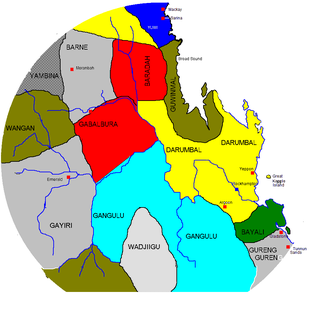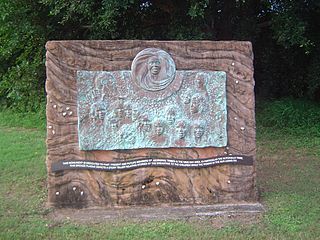 W
WThe Baradha people, also spelt Barada and Thar ar ra burra, and also known as Toolginburra, were an Aboriginal Australian people of Central Queensland not far inland from the east coast.
 W
WThe Baranha or Barna, also known as Barada Barna, are an Australian Aboriginal people of northern Queensland.
 W
WThe Butchulla, also written Butchella, Badjala, Badjula, Badjela, Bajellah, Badtjala and Budjilla are an Aboriginal Australian people of Fraser Island, Queensland, and a small area of the nearby mainland of southern Queensland.
 W
WThe Djabugay people are a group of Australian Aboriginal people who are the original inhabitants of mountains, gorges, lands and waters of a richly forested part of the Great Dividing Range including the Barron Gorge and surrounding areas within the Wet Tropics of Queensland.
 W
WThe Djagaraga or Gudang are an Australian Aboriginal tribe, traditionally lived in the coastal area from Cape York to Fly point, including also Pabaju, in the Cape York Peninsula, Queensland. In the early period of white settlement as the Somerset tribe, after the settlement of Somerset established on their lands in 1863.
 W
WThe Gabulbarra people, also rendered Gabalbura, Gabalbara and Kabalbara, is an Aboriginal Australian people of an area in eastern Central Queensland, but there is little recorded information about them.
 W
WThe Gangulu people, also written Kangulu, Kanolu, Kaangooloo and other variations, are an Aboriginal Australian people from the Mount Morgan area in Queensland, Australia.
 W
WThe Gayiri, people, also spelt or known as Kairi, Kararya, Kari, Khararya and Kaira, Bimurraburra, Gahrarja, Gara Gara, Ara Ara, and Kara Kara, are an Aboriginal Australian people of the state of Queensland.
 W
WThe Gubbi Gubbi people, also written Kabi Kabi incorrectly by the European people, are an Indigenous Australian people native to southeastern Queensland. They are now classified as one of several Murri language groups in Queensland.
 W
WThe Gudjal, also known as the Kutjala, are an indigenous Australian people of northern Queensland. They are not to be confused with the Kutjal.
 W
WThe Gugu Badhun are an Aboriginal nation whose country is located in the Upper Burdekin region of northern Queensland. Gugu Badhun country is approximately 220 km northwest of Townsville and includes the small township of Greenvale as well as a number of pastoral stations. The most comprehensive and up-to-date description of the nation is found in the book Gugu Badhun: People of the Valley of Lagoons, published in 2017.
 W
WThe Guugu Yimithirr, also spelt Gugu Yimithirr and also known as Kokoimudji, are an Aboriginal Australian people of Far North Queensland, many of whom today live at Hopevale, which is the administrative centre of Hopevale Shire. At the 2011 census, Hopevale had a population of 1,005 people. It is about 46 kilometres (29 mi) from Cooktown by road. It is also the name of their language. They were both a coastal and inland people, the former clans referring to themselves as a "saltwater people".
 W
WThe Injinoo were an Indigenous Australian people of the Cape York Peninsula, and their name now applies to a tribal aggregation of remnants of various tribes of the Cape York Peninsula.
 W
WThe Jagera people, also written Yagarr, Yaggera, Yuggara, Yuggera, Chepara-Yuggara, Chepara-Yugara, Ugarapul, Yugarabul, Yuggarapul, and Yugarapul are the Australian Aboriginal people who are the Traditional Owners of the territories from Moreton Bay to the base of the Toowoomba ranges including the city of Brisbane. The Turrbal people are of roughly a group from the north of Brisbane, but referring strictly speaking to a Jagera dialect.
 W
WKaurareg is the name for one of the Indigenous Australian groups collectively known as Torres Strait Islander peoples. They are lower Western Islanders, based on the Muralag group. In common with the other peoples of the Torres Strait Island, they commanded impressive sailing outrigger canoe technology, traded throughout the Straits, fishing and trading with other Torres Strait Island groups. Similarly, they also regularly visited the Australian mainland of Cape York Peninsula, and retained ceremonial, marriage and trading alliances with several Aboriginal Australian groups there. Subject to reprisals after being blamed for an incident in which a Western schooner and its crew were destroyed, their numbers rapidly diminished with the onset of white colonisation and administration. After World War II, descendants of the Kaurareg began to return to their traditional islands, and lay claim to native title over several of them.
 W
WThe Koinmerburra people, also known as Koinjmal, Guwinmal, Kungmal and other variants, are an Aboriginal Australian people of the state of Queensland. They are the traditional owners of an area which includes part of the Great Barrier Reef.
 W
WThe Kuku Nyungkal people are a group of Aboriginal Australians who are the original custodians of the coastal mountain slopes, wet tropical forests, waters, and waterfalls of the Upper Annan River, south of Cooktown, Queensland
 W
WThe Kuku Yalanji, also known as Gugu-Yalanji, Kuku Yalandji or Kokojelandji, are an Aboriginal Australian people originating from the rainforest regions of Far North Queensland.
 W
WThe Quandamooka people are an Aboriginal Australian group that live around Moreton Bay in Southeastern Queensland. They are composed of three distinct tribes, the Nunukul, the Goenpul and the Ngugi, and they live primarily on Moreton and North Stradbroke Islands, that form the eastern side of the bay. Many of them were pushed out of their lands when the English colonial government established a penal colony near there in 1824. Each group has its own language. A number of local food sources are utilised by the tribes.
 W
WThe Wadjiga people, also known as Wadja, Maudalgo, Wadjainggo, and other variants, were an Aboriginal Australian people of inland eastern Queensland.
 W
WThe Yambina were an Aboriginal Australian people of the state of Queensland, whose traditional lands lie inland (westwards) some distance from Mackay.
 W
WThe Yirrganydji (Irrukandji) people are an Indigenous Australian people of Queensland who trace their descent from the Irukandji and, as such, are the original custodians of a narrow coastal strip within Djabugay country that runs northwards from Cairns, Queensland to Port Douglas. Their traditional lifestyle was that of fishers along this coastal strip and around the river mouths, islands and seas between the Barron River and Port Douglas
 W
WThe Yugambeh are a group of Aboriginal Australian clans whose ancestors all spoke one or more dialects of the Yugambeh language. They are also alternatively known as the Chepara or the Mibin Their traditional lands are located in what is now south-east Queensland and the Northern Rivers of New South Wales, situated in the Logan City, Gold Coast, Scenic Rim, and Tweed City regions of Australia. Archaeological evidence indicates Aboriginal people have occupied the area for tens of thousands of years. By the time European colonisation began, the Yugambeh had a complex network of groups, and kinship.
 W
WThe Yuwibara, also written Yuibera and Juipera and also known as Yuwi, after their language, are an Aboriginal Australian people, originating from the area around present-day Mackay, on the east coast of Queensland, Australia.